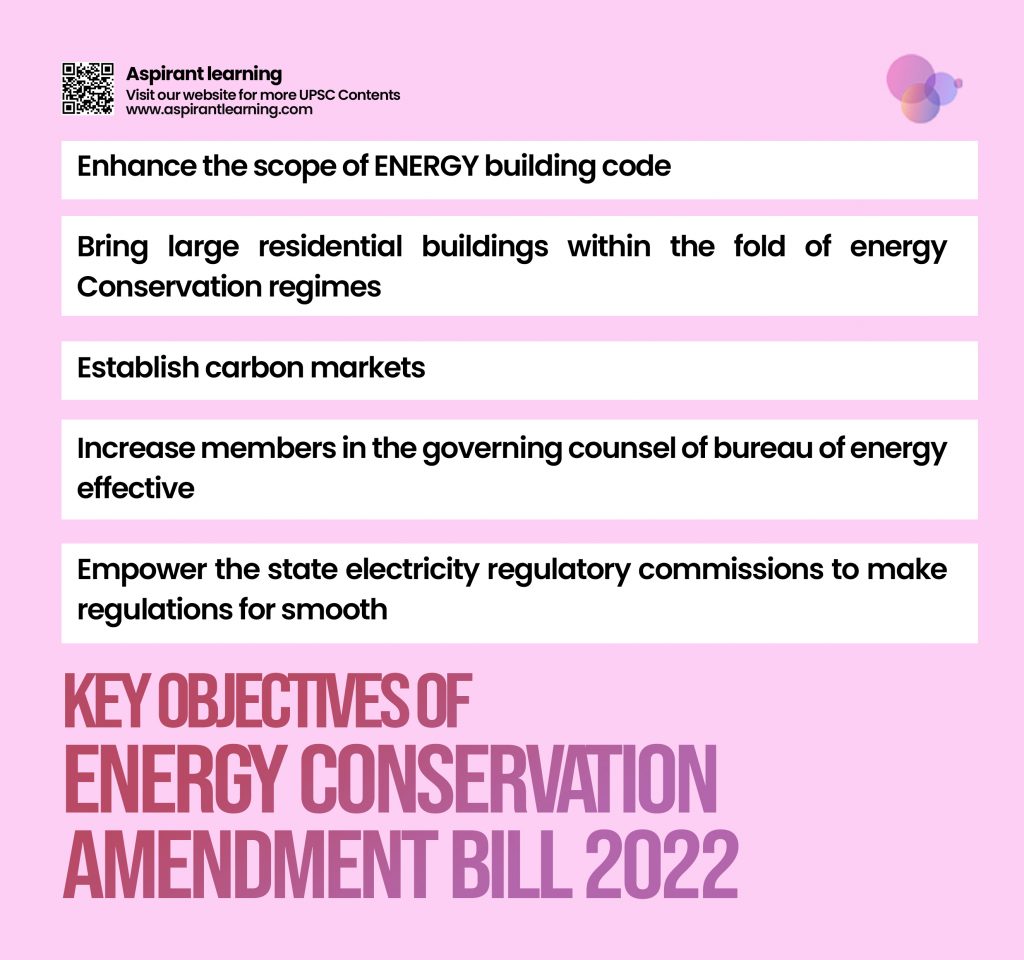News Highlight:
Minister of New and Renewable Energy R.K. Singh introduced the Energy Conservation (Amendment) Bill in Rajya Sabha
Key Takeaway:
- The Minister stated that the non-fossil fuel capacity was 42% of the total energy generation and in order to address the transition, the bill had been brought.
- The Bill proposes to amend the Energy Conservation Act 2001, last amended in 2010, to introduce changes such as incentivising the use of clean energy by issuing carbon saving certificates.
Energy Conservation Bill:
- Background:
- The bill seeks to amend the Electricity Conservation Act 2001 to include changes such as incentivising the use of clean energy through the issuance of carbon saving certificates.
- The Electricity Conservation Act 2001:
- Specify norms and standards of energy efficiency for appliances, industrial equipment and buildings.
- Prohibit the manufacture/ sale/ purchase of equipment unless it conforms to specified norms.
- Established the Bureau of Energy Efficiency (BEE).
- Empowers the Centre to issue energy savings certificates providing for a framework for energy trading – given to industries that consume less and can be sold to industries that consume more.
- Violators attract a penalty of Rs 10 lakh and consumers will be penalised as per their excess consumption.
- Appeals will be heard by the appellate tribunal established under the Electricity Act, 2003.

Key features of the Energy Conservation (Amendment) Bill 2022:
- Share of Renewable Energy:
- Defining the minimum share of renewable energy to be consumed by industrial units or any establishment.
- This consumption may be done directly from a renewable energy source or indirectly via the power grid.
- Carbon credit trading scheme:
- Incentivising efforts to use clean energy by issuing carbon saving certificates.
- Considering additional incentives like carbon credits for the use of clean energy to lure the private sector to climate action
- Carbon credit implies a tradable permit to produce a specified amount of CO2 or other GHG emissions.
- The central government/ authorised agency may issue tradable carbon credit certificates to entities compliant with the scheme.
- New Energy Conservation and Sustainable Building Code:
- Unlike the old code, this will also apply to the office and residential buildings with consumption above a threshold.
- Promoting green hydrogen:
- Facilitating the promotion of Green Hydrogen as an alternative to the fossil fuels used by industries.
- Strengthening Related Institutions:
- Bureau of Energy Efficiency: By changing the composition of its governing council including representatives of industries and consumers.
- Penal provisions:
- Failure to comply with standards will be punishable with a penalty of up to Rs 10 lakh.
Objectives of the Proposed Amendments:
- Its goal is to reduce GHG emissions and combat climate change.
- To expand India’s carbon market and promote the use of clean technology.
- To achieve its Nationally Determined Contributions (NDCs), as outlined in the Paris Climate Agreement, by 2030.
Need to amend the above Act:
- To consolidate on the current Act’s success.
- According to BEE, measures for efficient energy use saved approx. 28 million tonnes of oil equivalent energy in 2019-20.
- To facilitate the achievement of COP-26 goals to ensure faster decarbonisation of the Indian economy.

India’s climate change commitments:
- India has committed to reducing the carbon intensity of its economy by 33-35 % by 2030 from its 2005 levels as part of its NDCs under the Paris Climate Agreement.
- India has also promised to achieve over 40% of its power generation from non-fossil-fuel energy resources by 2030.
- In a bid to reduce its CO2 emissions to 550 metric tonnes (Mt) by 2030, India has committed to creating an additional carbon sink for 2.5 -3 billion tonnes of CO2 by increasing its tree and forest cover.
- India revised NDCs at the COP26 Summit held in Glasgow in November, 2021. India’s five new climate targets are:
- To increase its non-fossil energy capacity to 500 GW by 2030
- To meet 50 % of India’s power demand via renewable energy sources
- To reduce the carbon intensity of the Indian economy by 45 %.
- To reduce India’s total projected carbon emissions by one billion tonnes from 2021 to 2030
- To achieve a target net zero (for carbon emissions) by 2070.
Issues that need to be addressed:
- Ministry to regulate the carbon credit trading scheme:
- The Ministry of Power/ the Ministry of Environment is not clear
- There is no clarity on whether renewable energy, energy savings and carbon credit trading schemes involve the same or different activities
- Meeting non-fossil energy use obligations may adversely impact the competitiveness of the industry.
Pic Courtesy: freepik
Content Source: The Hindu



